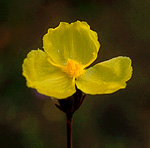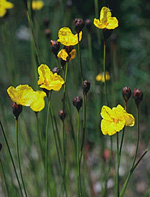 |
This family occurs throughout the tropics and subtropics of the world. In Australia it is represented only by its largest genus, Xyris, species of which are found from the Top End of the Northern Territory to northern Queensland, thence down the east coast as far as Tasmania and southern South Australia, with a few in southern Western Australia. They usually occur in sandy, moist soils in heathy vegetation.
Characteristic features of the family Xyridaceae in Australia include: - taprooted, grass-like plants with linear leaves in a basal tuft and usually stiffly erect, unbranched flowering scapes
- flowers in a globular head of dark bracts at the end of the scape
- perianth parts 6, the 3 inner ones prominent, thin and petal like, yellow or white, the flower open for only 1 day
- stamens 6, 3 fertile and 3 sterile, the latter tipped with hairs
- ovary superior, developing into a capsule
Description
Annual or perennial terrestrial herbs. Perennating by taproots or crowns. Internal secretions not obvious. Plants glabrous. Leaves distichous, all or mostly basal, sessile. Stipule-like lobes absent. Lamina simple, symmetric, filiform, acicular, subulate, linear or oblong; base attenuate or truncate; margins entire or dentate, ±flat; venation parallel, with the midrib conspicuous or inconspicuous, and the tertiary venation reticulate or not; surfaces not punctate; herbaceous. Leaf ligule present or absent. All the flowers bisexual. Inflorescences terminal, consisting of capitula, spikes, racemes, or apparently of spikelets. Bracts present. Flowers odourless, sessile or stalked. Perianth of 2 dissimilar whorls. Calyx irregular; segments free, of 3 sepals, imbricate in bud, papery. Corolla regular; segments free, of 3 petals, alternating with the sepals, usually crumpled in bud, yellow, without contrasting markings, membranous; claws present; lobes ±entire or notched, emarginate, bifid or bilobed. Fertile stamens 3, opposite to the sepals, free or at least partly fused to the corolla, free of the ovary and style, distinct from each other, all ±equal. Staminodes present or absent. Anthers basifixed, not versatile, opening outwards or sideways by longitudinal slits, 2-celled. Ovary superior and sessile. Carpels 3, fused; ovary with 3 locules. Style terminal, single and unbranched, or single and branched above. Ovules 5–numerous per locule, stalked; placentation parietal or axile. Fruit a dry, dehiscent loculicidal capsule; the perianth on the maturing fruit deciduous, rotting or liquefying, or dry and persistent. Disseminule micro-surface ±reticulate or finely costate, brown, dull. Seeds numerous per fruit. Aril absent. Cotyledons 1. Embryo straight.
(Note: this description has been generated from the coded data compiled for the key. Any errors in the key data will be reflected in the descriptions.)
A treatment of the family Xyridaceae has not yet been published in the Flora of Australia. It will appear in Volume 40.
Australian genera of Xyridaceae (as recognised for the Flora of Australia)
Xyris

|
  |

Xyris sp. (flower)
Photo: anon © ANBG

Xyris sp. (flower)
Photo: M.Fagg © ANBG
|
 |
|